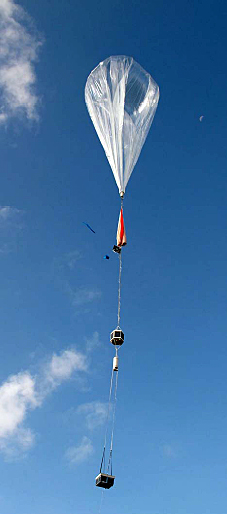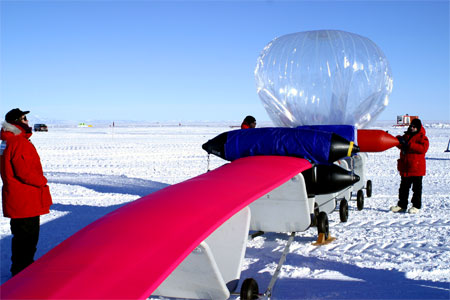Page 3/3 - Posted July 16, 2010
The technical detailsThis is not the first time CNES balloons have taken a spin around the atmosphere’s polar vortex above Antarctica. In 2005, an international program called VORCORE The French team investigated the vortex core mechanics to see how well it isolates the polar winter air. It is this isolation that allows the air to cool to PSC temperatures, and then for ozone to be destroyed by chlorine activated on PSCs during the winter. The team launched 25 stratospheric balloons that averaged 58.5 days in the air, the longest flight lasting 109 days — enough time to allow the scientists to also investigate the dissipation of the polar vortex in late spring. For that project, data were collected every 15 minutes. Concordiasi has seriously upgraded this capability to collect data at one-minute intervals. The longest flight should drift in the stratosphere for about four months. Three test flights of the system and instruments — two dropsondes and one PSC instrument — were completed in February 2010 from the Republic of the Seychelles. All balloons stayed aloft well over a month. The PSC instrument stayed floated around for about two-and-a-half months, eventually circling the Earth, according to Deshler. “It performed exceedingly well,” he said. In order for the numerous U.S. and French sensors and instruments to work for months at a time, they must be able to sip slowly on the limited power available on the balloon gondola, and they must start at initial temperatures as cold as minus 40 degrees centigrade, the design temperature for the gondola. These proved to be very challenging aspects of the project for many of the groups. 
Photo Credit: NCAR
A CNES balloon carries instruments aloft during a test in the Seychelles earlier this year.
“It was a pretty big instrument development activity,” Avallone said. The breakthrough for the University of Colorado team was swapping the ozone photometers light source from power-hungry mercury lamps to a more efficient light-emitting diode (LED). “It was a lot of laboratory and development work to make sure everything would function in the very severe temperature limits,” Avallone noted. “It’s not very common to be able to make a chemical measurement like this for just a couple of watts.” Deshler said the University of Wyoming had similar technical challenges, forcing them to develop instrumentation that could start in the extremely low temperatures expected in the gondola. The energy-saving plan for Wyoming’s instrument will be to turn the instrument on for two of every 15 minutes when the balloon enters an area of cold temperatures at 20 kilometers altitude. “There’s not enough power on the balloon gondola that we can operate continuously,” Deshler said. “We have to sample pretty deep into the cloud to see the formation of [the NAT] particles.” Rabier said there was a major effort undertaken to use solar energy to power the experiments. “However, there are still some batteries for some of the instruments. Before dropping the sondes, there is a warm-up cycle to bring the instrument to a reasonable temperature before starting the measurements,” she explained. Indeed, the polar spring, when darkness still prevails for much of the year, will present challenges for the solar-power-based instruments. But it’s the only time of the year that the researchers can make their measurements on the initial ozone depletion phase. In addition, the polar vortex will be well formed at that time, meaning that for the first weeks of the program, the balloons will stay trapped over the southern pole area, with a potential to get a lot of dropsonde data in this area, Rabier said. Still, the scientists expect a fast-paced schedule to complete all their plans. “One of the challenges in the field will be to launch in a relatively short amount of time up to 18 balloons, when each flight preparation takes a few hours and the wind conditions are not always favorable,” Rabier said. NSF-funded research in this story: Terry Deshler, University of Wyoming, Awards Nos. 0636946 and 0839124 Back 1 2 3
|



For USAP Participants |
For The Public |
For Researchers and EducatorsContact UsU.S. National Science FoundationOffice of Polar Programs Geosciences Directorate 2415 Eisenhower Avenue, Suite W7100 Alexandria, VA 22314 Sign up for the NSF Office of Polar Programs newsletter and events. Feedback Form |



